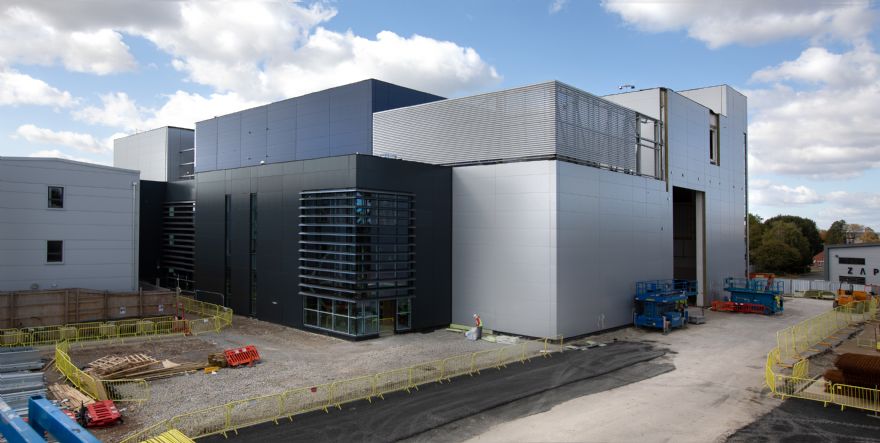
The front of the newly completed exterior of the National Satellite Test Facility. Photo: STFC RAL SpaceMore than 900 tonnes of steel framework has been installed and 3000m
3 of concrete poured to complete the main structure of the National Satellite Test Facility (NSTF) at the Harwell Campus in Oxfordshire.
The project is on its way to becoming the first of its kind in the UK to help larger and more-complex spacecraft prepare for launch with a a range of specialist equipment to test spacecraft.
Construction partners Mace have now installed the first piece of apparatus for the vibration facility and are currently working on the Electromagnetic Compatibility (EMC) chamber – which will offer an area free from electromagnetic background noise, where spacecraft electronics can be checked and tested.
Science Minister Amanda Solloway said: “By providing our flourishing space sector with the capacity to prepare larger, more-advanced spacecraft for launch, this cutting edge facility will help ensure the UK remains a world leader in space technologies for decades to come."
The NSTF will address the UK’s need for a complete set of large scale space test facilities in one building. It will be run by RAL Space, experts in testing and part of the UK's Science and Technology Facilities Council.
Professor Chris Mutlow, director of RAL Space, said: “I am delighted that we have passed this milestone — we are well on our way to opening our doors to the space sector.
“Large satellites require at least six months of testing before they're launched and this becomes longer and more expensive if all the test equipment is in different places. It is fantastic to see the test equipment shaping up under one roof.
“The space sector in the UK is thriving and we are looking forward to offering this one-stop-shop to support the development of larger and more-advanced spacecraft in the UK."
The suspension system, the first of the vibration equipment, has been successfully installed on the reaction masses, the two 250-tonne blocks on which the vibration system will stand.
At the NSTF, two 222kN thrust shakers will be used to simulate the vibration of launch and test the satellite in three axes. More than 1,500m
3 of earth was removed from site so that the vibration equipment could be sunk into the ground. The suspension system causes the vibration facility to 'float' completely isolated from the rest of the building.
This ensures that the vibrations from the shaker will not affect any of the other measurements taking place in the NSTF or by other sensitive scientific equipment nearby on the Harwell Campus in Oxfordshire.
Alongside the vibration facility, the NSTF will also offer EMC and antennae testing. This requires an electrically neutral space, built into the fabric of the building. 290m
2 of copper sheet have been laid into the floor of the chamber. Over the next few months this will be joined with copper wall and ceiling panels to create a copper shield through which electromagnetic waves cannot pass.
 Copper floor of the EMC chamber being laid in August 2020. Credit: STFC RAL Space
Copper floor of the EMC chamber being laid in August 2020. Credit: STFC RAL SpaceInside this ‘quiet’ zone, satellite manufacturers will be able to accurately measure the ‘noise’ that satellite antennae produce, ensuring that a high-quality signal is sent back to Earth for TVs, weather forecasts and science operations.
Rob Bridges, project director for Mace, said: “It is an honour to be leading the international multi-disciplinary team delivering the NSTF. From the first design workshop my team have been challenged to bring together a blend of technologies and innovations to design and deliver a future proofed, flexible building that will not only house specialist testing equipment but is required to be integral to the testing providing a stable environment, while using the structure as a dynamic part of the testing process."
The vibration equipment and EMC join the 7m diameter Large Space Test Chamber which arrived from Italy in April and will be able to test minibus-size satellites for the harsh conditions of space ranging from -180֯C to +100֯C.
The NSTF, being delivered by Mace and procured under the Southern Construction Framework, has been funded by UK Research and Innovation as part of the Industrial Strategy Challenge Fund.